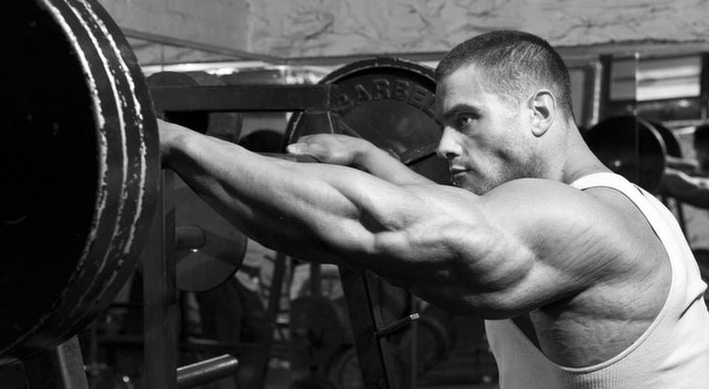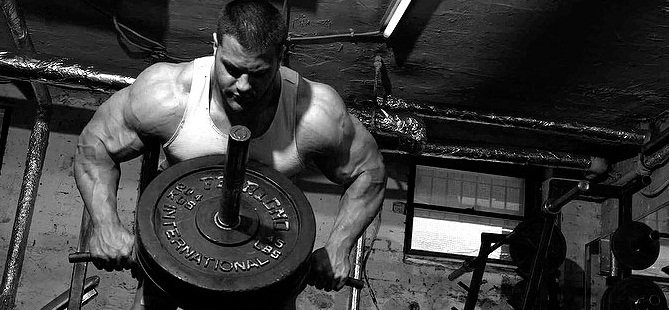Regardless of how you train, one thing should remain consistent: intensity.
 Unless you’re training at a high intensity level, optimum muscular development cannot be accomplished. Keep in mind there’s a fine line between maximum intensity and overtraining. Since training consistently at a high level can eventually lead to a state of overtraining, be sure to get adequate rest and nutrition. The whole point of training is to get the “pump.” The pump is it. Here’s how one pro described it: “The pump is the bodybuilder’s holy grail. It’s that full, engorged, satisfying feeling.
Unless you’re training at a high intensity level, optimum muscular development cannot be accomplished. Keep in mind there’s a fine line between maximum intensity and overtraining. Since training consistently at a high level can eventually lead to a state of overtraining, be sure to get adequate rest and nutrition. The whole point of training is to get the “pump.” The pump is it. Here’s how one pro described it: “The pump is the bodybuilder’s holy grail. It’s that full, engorged, satisfying feeling.
There’s nothing like it in the world. If you do a set of curls and you get a pump, your biceps will be full of blood.
All the nutrients that were in the blood, are now in that muscle. You’ve just fed them. You want to maximize and maintain this pump throughout your workout. If you lose the pump, you lose the entire workout. Since you don’t want to go into this unwanted territory, you must listen to your body. Say you’ve planned to do twelve sets on the bench. But maybe on your ninth set, you get this enormous, freakish pump. Forget the last three sets. Leave it alone.
Go on to the next exercise. It takes a lot of practice and patience. Beginners don’t know what they’re looking for, that feeling; they don’t know how to link their mind to their muscle. It takes time to develop this awareness. But once you do, you’ll see results faster than you ever dreamed possible.”

1. More Sets
The first and most obvious way to increase intensity is to add more sets. Sounds simple, right? Well remember this: For every extra set you add, you lengthen your overall training time. Longer and longer training sessions will tap deeper and deeper into your body’s recuperative powers.
So while it’s fine to add an additional set here and there, avoid falling into the trap of performing too many sets.

2. Cheating
Maybe you cheated on your diet last week, but there’s little room for cheating in the weight room. However, if used correctly, cheating can help you increase intensity. You should perform cheat techniques only after you’ve performed as many reps as you possibly can with proper form. For example, do as many barbell curls (using strict form) as you can until exhaustion. Now, using the combined strength of your legs, back and shoulders, heave the weight up. Though the stress is now dispersed throughout your entire body, you can still work the biceps.
One important note you should be aware of: Using cheat techniques from the first rep will only take stress off of the target muscle, leading to stalled progress and possible injury.

3. Negative Emphasis
When lowering a weight in an exercise (the negative portion of the exercise), lower it very slowly. As you do, count out to six, for example. Here’s what I mean: when performing a bench press, count from one to six slowly as you begin lowering the weight. The bar should hit your chest only when you reach the number six.
Though emphasizing the negative will greatly reduce the amount of weight you can use, your target muscle works harder, which ultimately means better gains. Less weight, more gains.

4. Forced Reps
With forced reps, you’re literally forcing your body to squeeze out additional reps with the assistance of a spotter.
The point here is simple: YOU should be working out, not your partner. The spotter should only help you complete the final rep or two of a set.

5. Drop Sets
Like forced reps, drop sets allow you to squeeze a little more intensity out of your tanks. As you reach failure on a particular set, strip some weight from the bar, and continue doing reps.
Drop sets allow you to fatigue muscle fibers which may have been missed during the regular set.

6. Rep Schemes
One of the constants in weight training is variety. Don’t let your body stagnate by doing the same exercises in the same order with the same number of reps. For instance, if you traditionally use higher reps, try using lower reps.
This isn’t to say lower reps are better, only that change is good. Variety is the spice of life.

7. Exercise Schemes
On a similar note, try replacing one exercise for another. For example, if you typically do barbell seated presses, try replacing them with dumbbell seated presses. By constantly rotating exercises, you can stay physically and mentally challenged.
Your training program should be like a riddle. Keep your body guessing at all times and watch it grow.

8. Specialization
Specialization is a way to spur a body part that is lagging.
If your delt progress is falling behind your triceps, add some new delt exercises, additional sets or other intensity methods to bring your shoulders up to par.
 References:
References:
www.animalpak.com
Photo Credits: Brian Moss










